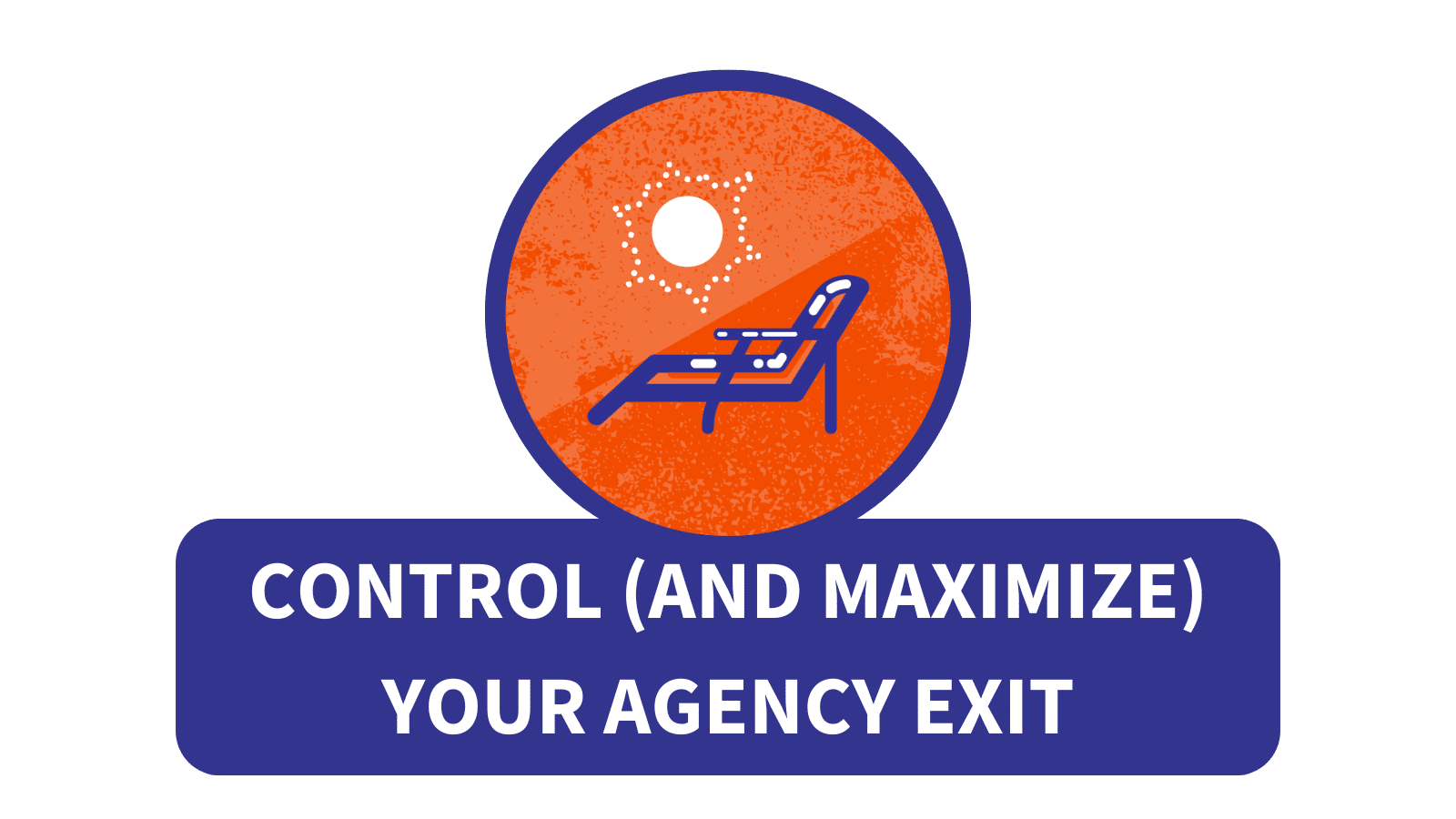Imagine what you’d do if you could cut your workload to 20-25 hours a week or less. I’ve helped several agency owners do this; it requires some tradeoffs and a lot of hard work, but the owners are typically happy with the result.
Why are they happier as a part-time agency owner? They have more time to pursue other interests, they tend to be less stressed, and they rarely miss the old version of their role. For example, check out this case study—on going part-time while increasing owner compensation.
Everyone’s unique, but there are certain similarities to the process for shifting to a part-time schedule. After all, “getting things off your plate” shouldn’t mean “scrape them on the floor for your team to clean up.”
Today, I’ll share the 10 steps to follow to help you become a part-time agency owner (if you choose). As an agency consultant, this is the non-custom version of the process I use with my Agency Growth Diagnostic and Executive Coaching clients.
- Confirm your long-term business direction, including Lifestyle vs. Equity.
- Identify your current spot on my Day-to-Day Involvement Meter.
- Decide where you want to move on the Day-to-Day Involvement Meter.
- Audit your current workload, to build an “inventory” of your responsibilities.
- Choose the “$1,000 an hour work” you still want to do.
- Define your future “just right” managerial mindset.
- Shift the agency structure to make you less mission-critical.
- Hire and/or develop people to do the activities you’ll no longer do.
- Create a transition plan to increasingly step away from what you don’t want to do.
- Enjoy your new reduced-hours role… and adjust as you hit speed bumps.
Let’s review what to expect, and then dig deeper on each of the 10 steps!
What to expect when you go part-time
First, keep in mind that part-time ownership is unusual—most agency owners aren’t working only 20-25 hours a week… or even trying to pursue that kind of a part-time workload. “Normal” at independent agencies is more like a workload of 50 hours a week.
If you want to become a part-time agency owner, I’ll assume you’re targeting to work 15-25 hours a week. The advice largely applies if you want to reduce your workload from 60-80 hours a week to 40-50 hours a week, too. Although it may sometimes feel like “two steps forward, one step back,” you’ll likely see some early wins to build momentum.
If you have one or more business partners, you have some big conversations ahead—they need to be on board with your changes, since the changes impact them, too.
Keep in mind that your transition process will likely take 6-24 months, depending on the gaps you need to close. My Executive Coaching program can accelerate your progress (and make things less stressful), but there’s no magic wand.
10 steps to become a part-time agency owner
An agency owner shared that he’s committed to work fewer hours this year. Specifically, he wants to reduce his workload from 40+ hours a week to 20 hours a week.
Sound like something you might like to do? Here’s how I think about the transition!
Keep in mind that a big gap is hard to close—for instance, if you’re trying to go from 60 or 80 hours a week down to 20 hours a week. Anything over 50 hours a week is hard in general. Why so hard? Because you’re making a huge reduction—you’re from the equivalent of two jobs down to the equivalent of half of one job.
1) Confirm your long-term business direction, including Lifestyle vs. Equity.
If you’re weighing multiple directions, try my 5-step framework for hard business decisions. It helps to understand your core Values, Goals, and Resources (VGR), as those drive where to focus—for instance, are you building a Lifestyle agency or an Equity agency?
At this point, some people decide they don’t want to keep running the agency, no matter how they might shift their workload and responsibilities. In that case, they should explore selling the agency (while taking extra care to protect themselves against burnout).
2) Identify your current spot on my Day-to-Day Involvement Meter.
That is, are you Mandatory, Necessary, Needed, or Optional? Haven’t seen the concept before? No worries—here’s more on the Day-to-Day Involvement Meter, including how to identify your current spot.
3) Decide where you want to move on the Day-to-Day Involvement Meter.
A part-time schedule typically requires getting to either Needed or Optional, depending on your hours target and the responsibilities you want to keep.
4) Audit your current workload, to build an “inventory” of your responsibilities.
This will include both day-to-day tasks, as well as occasional and longer-term responsibilities. After building the initial list, the “Time Bucket Template” in my Agency Profitability Toolkit can help you prioritize the categories that need the most attention.
5) Choose the “$1,000 an hour work” you still want to do.
What are “$1,000/hour” activities? They’re the things only you can do as the owner.
If you want to go part-time, that translates to choosing 2-4 from this list of 5 options:
- Must-do:
- Long-term business strategy
- Managing your direct reports
- Optional (do 0-2):
- Sales leadership
- Thought leadership marketing
- High-level client strategy
Remember, the more you choose to do from the “optional” list… the longer the hours you’ll work.
6) Define your future “just right” managerial mindset.
When you’re no longer working 40+ hours a week, you should neither micro-manage nor abdicate (that is, you shouldn’t jump-in constantly to “save the day” or question the team’s decisions, but also shouldn’t step back so far that the team flails without support). For many, this requires help from a coach and/or therapist, since it’s easier to be a bad boss than a good boss.
Want a 20-30 minute intro to succeeding as a manager? Read my 2016 pocket guide Made to Lead, for 31 bite-sized tips on how to do a better job when you’re wearing your “manager” hat.
I find micro-management is especially common when the owner has their name in the company name, and/or they’ve chosen one of their children as their successor. YMMV.
7) Shift the agency structure to make you less mission-critical.
A full-time agency owner ideally has no more than 5-7 direct reports, but a part-time owner needs to reduce their “span of control” to more like 2-4 direct reports. The exact number and structure will depend on the owner and the agency… but in general, “more employees = more drama.”
Not sure where to start making yourself less mission-critical? Read Turn the Ship Around! by David Marquet. In a hurry? See this whiteboard video for a 10-minute overview.
8) Hire and/or develop people to do the activities you’ll no longer do.
The “hire and/or develop” process might take 6-24 months, depending on the status of the current team and the extent to which your personal network drives lead-gen.
If you hire externally, you might be able to move faster… but you also risk hiring someone who’s a poor culture fit. If a key new hire doesn’t work out, you’ll have to start all over again… and now with a bigger mess.
9) Create a transition plan to increasingly step away from what you don’t want to do.
Your willingness to actually step away makes a big difference on timeline, too. After all, “just stopped by to see how you’re doing” quickly goes from helpful to annoying.
This is why Step #6 above (about your managerial mindset) is so important—I find that some people just don’t want to let go. Sometimes they’re control freaks. Sometimes they’re turning over the reins to one or more of their children. Sometimes it’s both.
10) Enjoy your new reduced-hours role… and adjust as you hit speed bumps.
You’ll surely have some issues along the way, but you can now feel more confident that you’re heading in the right direction for the next stage in your business career.
What can you do with an extra 10-30 hours a week?
Imagine you’ve reduced your workload dramatically—now what? I typically see part-time agency owners do one or more of the following:
- Build a new business within the agency (e.g., a product business).
- Run an entirely separate business, unrelated to the agency.
- Take care of children and/or parents.
- Volunteer to support a favorite non-profit.
- Travel, write a book, and/or pursue health and other personal development goals.
Nice, right? Definitely not something that most people in society can do… so I don’t recommend wasting the opportunity.
Want to do all of this, but not sure how you’d find the time? In a future article, I’ll share how to create time to make it happen. And in another future article, I’ll explore whether agency owners can achieve Tim Ferris’ hypothetical 4-Hour Workweek.
Question: If you choose to make yourself a part-time agency owner, what will you do with your new free time?


